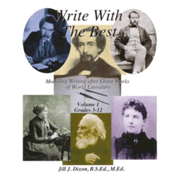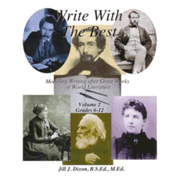Write with the Best is a two-volume writing curriculum that uses excerpts from great literature as models and springboards for students to develop writing skills in almost all genres of writing. It would fit very well within a classical approach to education, but it would also work well for anyone who likes the idea of using great examples of writing to inspire and teach students. The presentation has no evident religious perspective that I could spot.
The author suggests using Volume 1 with students in grades 3 through 12 and Volume 2 with students in grades 6 through 12. Obviously, with that wide of an age span, the amount of teacher direction and assistance required might vary dramatically. especially with the first volume which targets the broadest audience.
Volume 1 has 9 units and Volume 2 has 8 units. Each unit should take about 2 weeks to complete (a bit longer for units in Volume 2), which means each volume should take about one semester to complete. However, you could take longer with each unit, using a volume over an entire school year. Each volume has a list of additional literary passages for each unit so you might go through the volumes two or more times, using the different literary models to sharpen skills taught the first time around.
Instead of being given direct instruction on how to write "from scratch," students learn by emulating the excellent writing of the literary examples. The program assumes that students know how to write sentences, so it begins with the construction of a paragraph.
Parts of speech are briefly defined in the first lesson in Volume 1, then grammatical vocabulary is used to refer to sentence elements to help students edit and improve their writing. Some lessons direct students to identify grammatical items such as specific nouns and descriptive adjectives. An answer key at the back is provided for those activities as well as for other questions in Volume 2.
Since grammar instruction is not the focus of Write with the Best, the author recommends that students in grades 3 through 8 use Easy Grammar or Daily Grams for more comprehensive grammar instruction, and Strunk and White's Elements of Style for students in grades 8 through 12.
Volume 1 works on descriptive paragraphs for the first three units, then tackles dialogue, the short story, a fable, a friendly letter, poetry, and a ballad. Volume 2 begins with poetry (free verse), then continues with a business letter, taking notes/writing outlines/writing summaries, persuasive and expository essays, a literary critique and a book review, a newspaper article, a speech, and a dramatic monologue.
In every unit, students take dictation that the parent/teacher reads from the literary example for that unit. Parents/teachers need to decide how long a passage to give each student. Students correct their own work by comparing to the model.
Each unit also directs students to find another example of the genre of writing, either at home or at the library.
In addition, students are to look up definitions of unfamiliar words from the literary models—a vocabulary-building exercise, but one that will enable them to understand what they are reading or hearing. As you might surmise, a dictionary and thesaurus are essential tools for all students taking these courses.
A number of other "tools" are included at the back of each volume. Students use a copy of the reproducible "Proofreading Checklist" found in each volume to proofread their own work. A "Grading Criteria" guide helps parents evaluate student work. Tips for teaching to the different learning modalities (auditory, visual, kinesthetic) can be used as needed. The "How to Write Guide" provides concise summaries of the key points of each lesson.
Each volume comes in either a softcover book or looseleaf pages for you to put into a three-ring binder. The presentation is very basic and unadorned--no graphics or visual formatting for the lessons.
The courses were developed through the author's presentation of the lessons in group classes, so group use is clearly one way to use Write with the Best. In that case, lessons are taught from the binder. Interestingly, unit objectives that outline each assignment or step in the lesson are written directly to students. For example, "Finish your paragraph and add your concluding sentence" (V.1, p. 23). The layout and style of presentation make it possible for older students to work independently through the units, although they still need someone to give the dictation and evaluate work. Permission is given to copy only pages with the literary models and the "Proofreading Checklist," so if more than one student is working independently through the lessons, they each need their own book.











